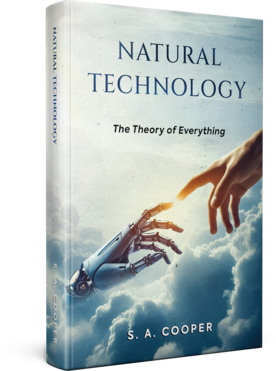The Ultimate Theory of Technology
Humanity’s Ongoing Hack of Nature
Image source: David Whelan, Wikimedia Commons.
In 2017, the WannaCry ransomware attack spread across the world by exploiting vulnerabilities in Microsoft Windows. Hospitals, power companies, and even governments were hit. The only way to stop it was through a patch — a piece of code written to correct the flaw and restore normal operations.
Let’s break down what happened.
There was an operating system with a defined architecture.
Hackers exploited its interfaces.
Engineers responded by debugging the code and inserting new instructions.
The event unfolded this way because the software was structured as a system that could be read, modified, and repaired.
What happens in software has a clear parallel in biology. Gene therapy works on the same principle. When a genetic disorder appears, the solution is not to reinvent life from scratch but to patch the code that’s misfiring.
Now let’s break down what happens.
There is a genome with a defined sequence and structure.
Viruses, lipids, or nanoparticles are used to access the cell’s interfaces.
Scientists insert or modify genetic instructions, essentially debugging the system.
The process succeeds only because DNA functions as a readable, writable codebase. Like software, it can be hacked, patched, and reprogrammed.
And when you look at actual cases in medicine, the pattern becomes even clearer.
Luxturna: delivers a working gene into retinal cells, restoring sight to people born blind.
Zolgensma: replaces a faulty gene in infants with spinal muscular atrophy, saving lives that would otherwise be lost.
CAR-T therapy: reprograms immune cells to recognize and destroy cancer.
mRNA vaccines: deliver temporary instructions for cells to produce a protein, prompting immunity — essentially an “app” that installs, runs, and then disappears.
Each case is a live demonstration of how life can be read, hacked, and reprogrammed like technology.
What medicine reveals through therapy, biology demonstrates on its own every day. Gene therapy shows how we interact with biology as if it were engineered. But the deeper truth is that biology itself is already technological:
DNA repair enzymes are built-in debugging routines.
Immune memory functions like caching, storing prior responses for faster recall.
The blood–brain barrier works as a firewall, controlling access to a protected environment.
Apoptosis acts as a fail-safe shutdown when corruption can’t be fixed.
Cell signaling operates like networking protocols, passing encrypted instructions between nodes.
Our medicine succeeds only because the system has these properties in the first place. We are not imposing technology onto biology; we are uncovering it.
All of this points to a simple conclusion. The more deeply we interact with living systems, the less they resemble raw chemistry and the more they resemble architecture.
They have code (DNA).
They have interfaces (membranes, receptors).
They have defenses (immune checks, repair enzymes).
They allow patches and updates (gene therapy, vaccines).
Life is not a crude accident. It is organized, coded, defended, and updatable technology — and gene therapy makes that undeniable.
Look anywhere in living systems, and examples of natural technology are endless. It is our technologies that are the analogies — late and partial imitations. These natural technologies is something our own inventions only confirm.
In humans, the heart is a pump that runs for decades without rest, adapting and repairing itself. Our pacemakers are remarkable devices, but they exist to keep pace with what the heart has been doing all along.
The eye instantly refocuses whether we’re looking at a page, a face, or a skyline. At the optometrist, the autorefractor has to shuffle through lenses and calculate, but your lens does it seamlessly, automatically, and without a thought.
The ear can pick up the faintest sound in a noisy room. Our hearing aids are clever devices, but they confirm the deeper reality — that auditory systems are already a sophisticated technology. The nose can identify thousands of chemicals, mixtures, and intensities. Smoke alarms detect one or two threats; olfaction confirms that living systems long ago mastered chemical detection at a level our devices cannot reach.
Joints, too, are a natural technology. The hinge in a wrench, the ball joint in machinery, even the bearings in our vehicles — all confirm the ingenuity already present in knees, elbows, and hips. We don’t invent joints out of thin air; we recognize them in biology and reproduce them in our machines.
And beyond humans, the same truth spreads everywhere. Bats navigate with sonar long before submarines. Sharks detect electrical signals in water long before we built sensors. Spiders spin silk stronger than steel, and geckos climb walls with microstructures that engineers still cannot fully match.
Pumps, pacemakers, hearing aids, smoke detectors, joints, cameras, motion sensors — all of them are only reminders of the natural technologies that came first. This is why I call it Natural Technology.
The Theory of Natural Technology is not just another philosophy of machines. It is the ultimate theory of technology. It is a model that defines technology as coherence shaped by intention, layered in design, operation, and meaning. This theory shows that nature is the prime technology, and that our own inventions intuitively draw from it — something long undetected, yet as natural as a newborn drawing from its mother. Read more in Natural Technology: The Theory of Everything.

